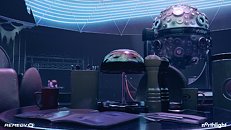Raevenlord
News Editor
- Joined
- Aug 12, 2016
- Messages
- 3,755 (1.15/day)
- Location
- Portugal
| System Name | The Ryzening |
|---|---|
| Processor | AMD Ryzen 9 5900X |
| Motherboard | MSI X570 MAG TOMAHAWK |
| Cooling | Lian Li Galahad 360mm AIO |
| Memory | 32 GB G.Skill Trident Z F4-3733 (4x 8 GB) |
| Video Card(s) | Gigabyte RTX 3070 Ti |
| Storage | Boot: Transcend MTE220S 2TB, Kintson A2000 1TB, Seagate Firewolf Pro 14 TB |
| Display(s) | Acer Nitro VG270UP (1440p 144 Hz IPS) |
| Case | Lian Li O11DX Dynamic White |
| Audio Device(s) | iFi Audio Zen DAC |
| Power Supply | Seasonic Focus+ 750 W |
| Mouse | Cooler Master Masterkeys Lite L |
| Keyboard | Cooler Master Masterkeys Lite L |
| Software | Windows 10 x64 |
After we've covered news of UL's (previously known as 3D Mark) move to include a raytracing benchmark mode on Time Spy, the company has contacted us and other members of the press to clarify their message and intentions. As it stands, the company will not be updating their Time Spy testing suite with Raytracing technologies. Part of the reason is that this would need an immense rewrite of the benchmark itself, which would be counterproductive - and this leads to the rest of the reason why it's not so: such a significant change would invalidate previous results that didn't have the Raytracing mode activated.
As such, UL has elected to develop a totally new benchmark, built from the ground up to use Microsoft's DirectX Raytracing (DXR). This new benchmark will be added to the 3D Mark app as an update. The new test will produce its own benchmarking scores, very much like Fire Strike and Time Spy did, and will provide users with yet another ladder to climb on their way to the top of the benchmarking scene. Other details are scarce - which makes sense. But the test should still be available on or around the time of NVIDIA's 20-series launch, come September 20th.


View at TechPowerUp Main Site
As such, UL has elected to develop a totally new benchmark, built from the ground up to use Microsoft's DirectX Raytracing (DXR). This new benchmark will be added to the 3D Mark app as an update. The new test will produce its own benchmarking scores, very much like Fire Strike and Time Spy did, and will provide users with yet another ladder to climb on their way to the top of the benchmarking scene. Other details are scarce - which makes sense. But the test should still be available on or around the time of NVIDIA's 20-series launch, come September 20th.


View at TechPowerUp Main Site




 )
)